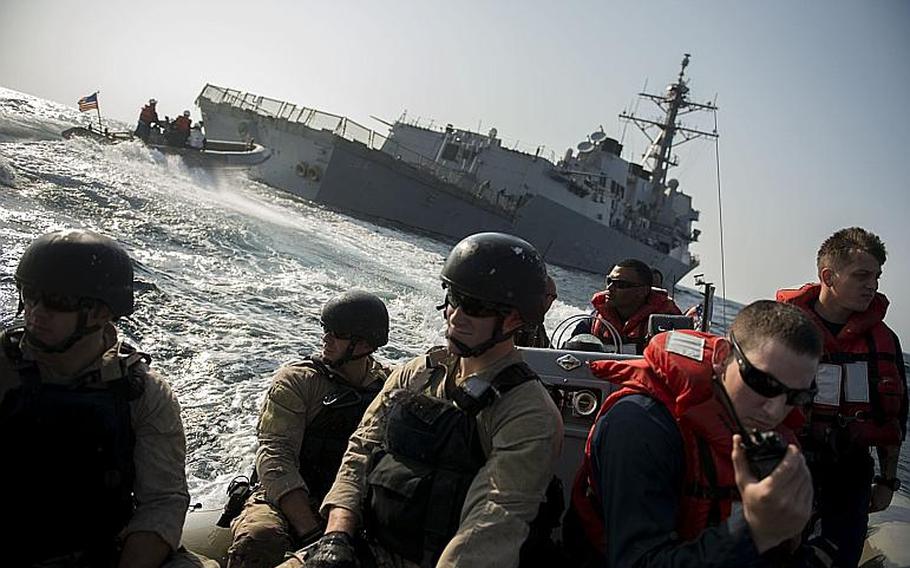News
Navy’s push to fill billets at sea may result in uncertainty for sailors
Stars and Stripes March 18, 2014

Sailors assigned to the guided-missile destroyer USS Bulkeley prepare to conduct a visit, board, search and seizure exercise in the Gulf of Oman. Bulkeley is deployed as part of the Harry S. Truman Carrier Strike Group in the U.S. 5th Fleet area of responsibility. (Donald R. White Jr./U.S. Navy)
U.S. Navy officials are determined to fill 7,000 vacant billets at sea by giving detailers increased authority to alter transfer dates.
It’s the latest of several policy changes in recent years to push sailors to go haze gray and underway. Two years ago, the Navy had 15,000 gapped billets at sea, officials say.
The new policy, which was released on March 14, authorizes detailers to transfer enlisted sailors six months before their projected rotation date and as late as six months after their PRD.
There are two main reasons for the change: to give detailers the flexibility to curtail shore assignments in order to fill sea duty vacancies on time with qualified personnel, and to hold sailors at sea longer if a qualified replacement can’t be found for their billet.
“That’s where we need them the most, that’s where our Navy is going to be focused now and into the future,” said Lt. Cmdr. Chris Servello, a spokesman for the chief of naval personnel.
Servello stressed the importance of filling and preventing gaps from occurring in sea duty billets. He said he expects the change will affect about 2 percent of transferring sailors. “We don’t think we will have to do it very often, but if we need to, we need to make sure we have the authority to make that happen,” he said.
The added flexibility to fill billets at sea may have unintended consequences, such as increased uncertainly for sailors who may get short notice they are transferring early or staying at sea longer. “We absolutely are conscious of the stress this can cause sailors and families,” Servello said. He urged sailors to keep in close touch with their career counselors to mitigate that uncertainty.
Chief Petty Officer Mario Maytorena, the command career counselor at the Navy base in Bahrain, foresees concern by sailors about going to shore-duty assignments without knowing if they will complete a full tour. Maytorena describes various scenarios in which sailors on shore duty may or may not be affected, depending on a sailor’s tour length, location, rate and qualifications. ”What we are here to do is to provide the guidance for the sailors,” he said, adding that it’s a career counselors’ job to dissect and explain to sailors how this might affect them specifically.
In some cases, sailors may be informed 18 months into a 36-month shore assignment that they may be sent back to sea early.
“The detailers are going to look to give sailors a max heads up so that it isn’t a surprise,” Servello said. He acknowledged that sometimes that isn’t possible.
Detailers will seek out volunteers first, officials say. The change may also be an opportunity for sailors who feel stuck in their current shore assignments to opt for a more career-enhancing shipboard billet that may pay more because of the Navy’s sea-pay allowance.
But one consequence in yanking some sailors from shore duty early is that some shore-duty billets may be vacant for months. Navy officials say they recognize that there may be a short-term impact to shore-duty billets, but they are comfortable they can overcome it.
Maytorena said sailors and commands will still have a 30-day window to submit a rebuttal if a sailor’s early departure from a shore command results in undue impact to the mission or the sailor. But he cautions that manning the fleet will still be the likely priority. “Every Sailor is important to the command, but we just have to ensure what works best to support the fleet.”
For months the Navy has been focused on its “forward presence.” Earlier this month, the Navy announced its first increase in sea pay in more than decade — 25% for most sailors. In a worldwide all-hands call on March 5, the chief of Naval personnel, Vice Adm. Bill Moran, told sailors the Navy would be asked to do more forward, informing sailors of potentially longer deployments as the war in Afghanistan wound down. “As those folks pull back you’ve got to have a defensive back out there somewhere to makes sure no one gets into mischief,” he said.
simoes.hendrick@stripes.com Twitter: @hendricksimoes